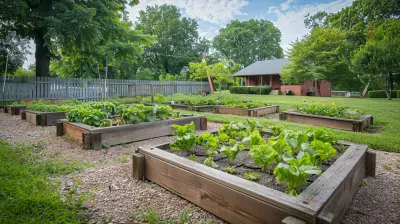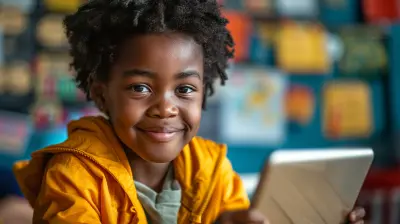Supporting Project-Based Learning at Home
2 December 2024
In today’s rapidly evolving world, traditional methods of learning are slowly being replaced with more interactive, hands-on approaches. One of the most popular and effective methods is Project-Based Learning (PBL). But, what if I told you that PBL isn't just for the classroom? Yep, that's right. You can totally support and implement this approach at home! In fact, the home environment provides a perfect space for creativity to flourish, making it an ideal place for project-based learning.
Whether your child is already participating in PBL at school, or you're simply looking for ways to foster curiosity and problem-solving skills at home, this guide will help you create a supportive environment for project-based learning. So, let’s dive in!
What is Project-Based Learning?
First off, let’s define Project-Based Learning. PBL is an instructional approach where students learn by actively engaging in real-world and personally meaningful projects. Instead of passively receiving information, learners explore a subject by tackling projects that require critical thinking, problem-solving, teamwork, and self-management.In most cases, students are presented with a driving question or problem that they must solve through research, inquiry, and experimentation. Think of it like this: instead of memorizing facts about ecosystems, students might design their own mini ecosystem complete with plants, animals, and environmental factors!
Now, here’s where things get exciting. This method doesn’t just have to be restricted to the classroom. You, as a parent or guardian, can create a goldmine of learning opportunities right at home.
Why Is Project-Based Learning Important?
Before we dive into how to support PBL at home, let’s talk about why it’s important. Why should you care about project-based learning in the first place?- Encourages Independent Learning: PBL inspires kids to take control of their own learning. Instead of spoon-feeding them information, they have to find answers themselves, which builds independence and resourcefulness.
- Develops Critical Thinking: Since PBL often revolves around solving complex, real-world problems, it pushes students to think critically and creatively. They’ll have to analyze information, weigh different perspectives, and come up with solutions.
- Promotes Teamwork: Many PBL activities are collaborative, meaning your child will learn how to work well with others – a crucial life skill!
- Fosters Curiosity: PBL taps into a child’s natural curiosity by allowing them to explore topics they’re genuinely interested in. This keeps them engaged and excited about learning.
- Prepares for the Real World: In the real world, we rarely solve problems in isolation. PBL mirrors this by requiring learners to combine different subjects and skills to address a challenge.
Now that we’ve established why PBL is such an awesome approach, let’s talk about how you can bring this method into your home.
How to Support Project-Based Learning at Home
1. Create a Space for Learning
First things first – your child needs a designated space to work on their projects. Now, don’t worry, this doesn’t need to be a fancy science lab or a fully equipped workshop. Just a quiet, clutter-free area where they can spread out their materials and think creatively.Think of this space as their “lab” – a place where they can make mistakes, get messy, and experiment with ideas. Make sure the area has all the tools they need, whether it’s books, pens, art supplies, or even a computer for research.
Also, let’s not forget the importance of flexibility. Some projects might require outdoor exploration or a kitchen for science experiments. Be open to adapting the learning environment to the needs of the project.
2. Encourage Questioning and Curiosity
One of the key aspects of PBL is that it’s driven by questions. Start by encouraging your child to ask questions about the world around them. Instead of just answering their questions outright, challenge them to find the answers themselves.For example, if your child asks, "Why do plants grow towards the sunlight?" you might respond with, “That’s an excellent question! How could we figure that out?” Maybe they’ll decide to grow some plants in different lighting conditions and observe what happens.
Curiosity is the engine that drives PBL, so don’t be afraid to let your child explore topics that interest them, even if they stray from the traditional curriculum. Remember, the goal is to ignite a love for learning, not just to check off boxes.
3. Break Down the Project into Manageable Steps
Project-based learning can sometimes feel a little overwhelming, especially for younger kids. That’s why it’s important to help them break down their projects into smaller, more manageable steps.Let’s say your child wants to create a model of the solar system. Instead of diving right into the big task, you can help them break it down like this:
- Step 1: Research the planets and their distances from the sun.
- Step 2: Gather materials (paper, paint, styrofoam balls).
- Step 3: Create a blueprint of the model.
- Step 4: Build the planets.
- Step 5: Assemble the solar system model.
By creating smaller milestones, your child will feel a sense of accomplishment as they complete each step, which will help keep them motivated.
4. Provide Guidance, Not Answers
One of the hardest things for parents is resisting the urge to swoop in and provide answers when their child hits a roadblock. However, PBL is all about problem-solving, and part of that process is working through challenges.Instead of giving your child the answer, ask open-ended questions that guide them toward a solution. For example, if they’re trying to figure out how to make their solar system model stand upright, you might ask, “What are some ways we can make this structure more stable?”
This approach teaches children that it’s okay to struggle and that persistence is key to solving problems. It also helps them develop confidence in their ability to find solutions on their own.
5. Integrate Real-World Connections
One of the things that makes PBL so powerful is its connection to the real world. Whenever possible, try to link projects to real-world issues or challenges. This not only makes the learning more relevant but also helps your child see how their knowledge can be applied in practical ways.For instance, if your child is learning about environmental science, you could encourage them to start a small recycling initiative at home or create a presentation on how to reduce waste in your household. These kinds of projects show children that their learning has a direct impact on the world around them.
6. Collaborate and Celebrate Effort
Remember, PBL is often collaborative. While your child may be working solo, there are still opportunities for collaboration – whether it’s with you, siblings, or even friends virtually. Encourage them to share their progress, brainstorm ideas together, and seek feedback.And when the project is complete? Celebrate the effort! Whether it’s a “show and tell” with the family or a small presentation to friends, make sure your child feels proud of the work they’ve done. After all, learning is a journey, and recognition plays a huge role in keeping that spark alive.
Examples of Project-Based Learning Ideas for Home
If you’re looking for some inspiration, here are a few fun and educational PBL ideas you can try at home:1. Science: Build a Weather Station
Help your child design and build a simple weather station to track temperature, humidity, and wind. They can record data over several weeks and analyze trends, comparing their findings to local weather reports.2. Math: Design a Budget for a Family Event
Get your child involved in planning a family event, like a birthday party or holiday gathering. They can create a budget, compare prices, and make decisions on how to allocate funds for decorations, food, and entertainment.3. History: Create a Historical Documentary
Pick a historical event that interests your child and have them research it in-depth. They can then create a short documentary using video clips, images, and narration. This project could even involve interviewing family members who have stories related to that time period.4. Art: Create a Community Mural
If your child is artistically inclined, encourage them to design a mural that represents the community. They can research local history, culture, and values, and then create sketches or even a digital mock-up of their masterpiece.Overcoming Challenges
Let’s be real, supporting PBL at home isn’t always going to be smooth sailing. There will be moments of frustration, dead-ends, and even tantrums (from both the kids and, let’s face it, the parents). But that’s okay! The key is to stay patient and remember that PBL is a process.When things get tough, remind your child that failure is part of learning. Encourage them to reflect on what went wrong and how they can improve next time. This growth mindset will serve them well far beyond their projects.
Conclusion
Supporting project-based learning at home is an incredible way to foster creativity, critical thinking, and a love for exploration in your child. By creating a supportive environment, encouraging curiosity, and guiding them through challenges, you’re setting them up for success – not just in school, but in life.So, go ahead, embrace the mess, the questions, and the endless possibilities. Who knows? You might just find yourself learning something new, too!
all images in this post were generated using AI tools
Category:
Parent InvolvementAuthor:

Zoe McKay
Discussion
rate this article
19 comments
Sara Pope
Empower your child’s education by embracing project-based learning at home! Encourage curiosity, creativity, and critical thinking. Together, let's ignite a passion for discovery and prepare them for a brighter future. The journey begins with you!
January 30, 2025 at 4:13 AM

Zoe McKay
Thank you for your insightful comment! Embracing project-based learning at home truly fosters essential skills and ignites a lifelong love for learning in children. Let's inspire curiosity and creativity together!
Madalyn McCall
Empower learning with hands-on projects!
January 26, 2025 at 1:29 PM

Zoe McKay
Absolutely! Hands-on projects actively engage learners and reinforce concepts, making education more meaningful and enjoyable.
Marni Dodson
Absolutely loved this article! Project-based learning at home can spark creativity and curiosity. Let's embrace the messiness of learning together—every project is a chance for fun and discovery! Keep inspiring!
January 23, 2025 at 1:25 PM

Zoe McKay
Thank you so much for your kind words! Embracing the messiness truly opens the door to creativity and discovery. I'm glad you loved the article!
Zaylee McCollum
Great article! Project-Based Learning can truly spark creativity and critical thinking in kids. Your tips for supporting it at home are practical and encouraging. It's inspiring to see how parents can play a vital role in their children's learning journey!
January 21, 2025 at 3:19 AM

Zoe McKay
Thank you for your kind words! I'm glad you found the tips helpful—parents truly make a difference in nurturing creativity and critical thinking through Project-Based Learning.
Vienna Clayton
Empowering students through project-based learning at home fosters independence and critical thinking skills effectively.
January 18, 2025 at 12:22 PM

Zoe McKay
Thank you! Project-based learning truly cultivates independence and critical thinking, making it an excellent approach for students at home.
Soren McDowney
Great tips! Supporting project-based learning at home not only fosters creativity but also strengthens family bonds. Excited to try these ideas with my kids!
January 16, 2025 at 1:59 PM

Zoe McKay
Thank you! I'm glad you found the tips helpful—enjoy the creative time with your kids!
Juliana Patel
Empowering students at home enhances their project-based learning experience significantly.
January 12, 2025 at 12:44 PM

Zoe McKay
Absolutely! Empowering students at home fosters independence and creativity, making project-based learning more impactful and enriching.
Ella Walker
This article offers practical insights for parents, emphasizing the importance of fostering creativity and critical thinking in children through project-based learning; a valuable approach for home education.
January 6, 2025 at 7:56 PM

Zoe McKay
Thank you for your feedback! I'm glad you found the insights on fostering creativity and critical thinking through project-based learning valuable for home education.
Atlas McCullough
Turn your living room into a project lab! Who knew science experiments could involve so much glitter?
December 30, 2024 at 7:58 PM

Zoe McKay
Thanks for your enthusiasm! Glitter can definitely add a fun and creative touch to science experiments at home!
Samuel McGuffin
Great insights! Project-based learning at home fosters creativity and critical thinking. Parents play a crucial role in this process.
December 27, 2024 at 7:47 PM

Zoe McKay
Thank you! I completely agree—parents are essential in cultivating an environment that encourages creativity and critical thinking through project-based learning at home.
Kristen McBride
What a fantastic guide! Project-based learning at home can turn everyday moments into exciting educational adventures. Embrace the messiness and creativity, and remember that every little project is a step towards discovery. Dive in, have fun, and watch your child’s curiosity flourish! You’ve got this!
December 25, 2024 at 8:22 PM

Zoe McKay
Thank you! I'm glad you found the guide helpful. Embracing the journey of project-based learning truly makes a difference in fostering curiosity and creativity!
Piper Hamilton
Project-based learning at home fosters creativity and critical thinking; essential for children's development.
December 19, 2024 at 3:20 AM

Zoe McKay
Absolutely! Project-based learning nurtures essential skills like creativity and critical thinking, making it a powerful tool for children's development at home. Thank you for highlighting its importance!
Ursula Mendoza
Empower curiosity; ignite learning at home!
December 16, 2024 at 3:55 AM

Zoe McKay
Absolutely! Fostering curiosity at home is key to enhancing project-based learning. Let’s inspire creativity together!
Calyx McIntosh
Engaging in project-based learning at home fosters curiosity and critical thinking—essential skills for lifelong success.
December 13, 2024 at 4:34 AM

Zoe McKay
Thank you for emphasizing the importance of project-based learning! Fostering curiosity and critical thinking at home truly sets the foundation for lifelong success.
Lanae Hamilton
What innovative strategies can parents use to enhance project-based learning at home? I'm curious about practical tips that can make learning more engaging and impactful for kids outside the classroom!
December 11, 2024 at 1:24 PM

Zoe McKay
Parents can enhance project-based learning at home by incorporating hands-on activities, such as DIY projects or science experiments, utilizing everyday materials for creative problem-solving, fostering collaboration through family challenges, and connecting projects to real-world issues to spark curiosity and relevance.
Morgan Meyers
Project-Based Learning thrives when families actively engage in curious exploration. By fostering an environment of inquiry at home, parents can support their children’s learning journeys. Encouraging collaboration on meaningful projects not only enhances academic skills but also strengthens family bonds through shared experiences and discoveries.
December 4, 2024 at 9:27 PM

Zoe McKay
Thank you for highlighting the crucial role of family engagement in project-based learning! Your insights on fostering inquiry and collaboration at home truly emphasize how these experiences can enrich both learning and family connections.
Indigo McGuffin
This article offers invaluable insights for parents navigating project-based learning at home. By fostering creativity and encouraging exploration, we can support our children’s growth and confidence. Thank you for sharing such practical tips to enhance their learning experiences!
December 3, 2024 at 5:02 AM

Zoe McKay
Thank you for your kind words! I'm glad you found the tips helpful for supporting your child's learning journey.
Lysara McRae
Great article! Supporting project-based learning at home can be a fun adventure—let’s inspire our kids to explore and create together!
December 2, 2024 at 9:54 PM

Zoe McKay
Thank you! I completely agree—project-based learning can be an exciting way for families to bond while exploring new ideas together!
Owyn Holland
This article offers valuable insights into enhancing project-based learning at home. It emphasizes the importance of guidance and resources, empowering parents to foster creativity and critical thinking in their children.
December 2, 2024 at 1:53 PM

Zoe McKay
Thank you for your thoughtful feedback! I'm glad you found the insights valuable for enhancing project-based learning at home.
MORE POSTS

Why Peer Tutoring Works: A Look at Collaborative Learning

How to Avoid Miscommunication in Multicultural Teams

Peer Tutoring and Its Role in Promoting Equity in Education

Best Study Abroad Destinations for Students in STEM Fields

The Importance of Cultural Awareness in Communication

School Gardens: Growing More Than Just Plants

How EdTech is Making Education More Inclusive for Students with Disabilities

How to Foster Creativity in the Classroom

How to Travel on a Budget While Studying Abroad

Virtual Classrooms vs. Traditional Classrooms: A Comparative Guide

The History of Slavery: A Global Perspective

The Role of Artificial Intelligence in Supporting Teacher Workload